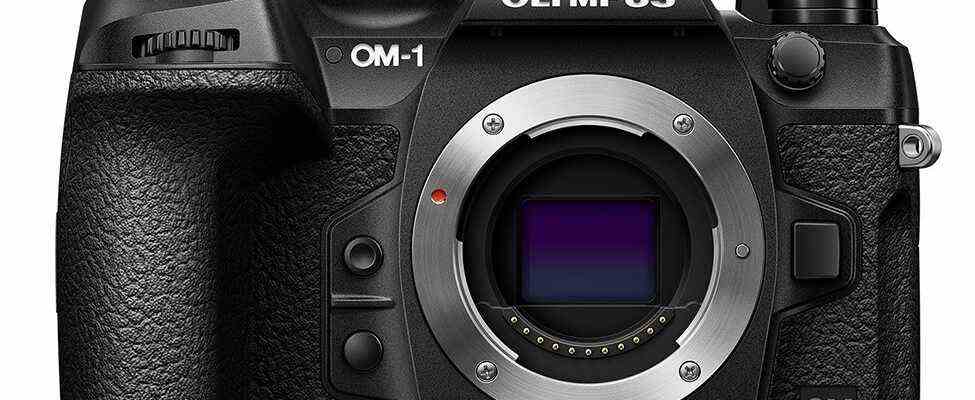20.4 Megapixel Stacked Live MOS sensor, up to 120 fps, 5.76M viewfinder, 4K60p video
As the first camera under the new “OM System” label, OM Digital Solutions has introduced the OM System OM-1. The mirrorless system camera is the company’s new flagship and brings some technical innovations with it. This applies to the image converter, among other things, although its size (17.3 x 13.0 mm) and resolution (20 megapixels) have not changed. However, the structure is new: It is a Stacked BSI Live MOS sensor with Cross Quad Pixel AF. The image converter is backlit, has an additional DRAM cache and uses a new focus technology for focusing.

The “stacked structure” and the additional DRAM cache of the sensor allow particularly fast readout and therefore a significantly lower rolling shutter effect as well as significantly higher frame rates. At full resolution, the OM System OM-1 captures up to 120 frames per second with single pre-focusing (AF-S), with continuous autofocus (AF-C) up to 50 frames per second are possible. According to OM Digital Solutions, the latter option requires specific PRO lenses, examples include the M.Zuiko Digital ED 12-40mm F2.8 II PRO, the M.Zuiko Digital ED 12-100mm F4 IS PRO and the M.Zuiko Called Digital ED 40-150mm F2.8 PRO.
According to the manufacturer, RAW photos are possible even at the highest frame rates, at 120 frames per second 92 of them in a row. The electronic shutter is active for both frame rates mentioned, with a mechanical shutter (durability 400,000 releases) up to ten frames per second can be recorded. The well-known Pro Capture mode is also on board again, so you can capture photos before you press the shutter button.
Furthermore, the OM System supports OM-1 High Res Shots. Here you can choose between tripod recording (up to 80 megapixels) and handheld recording (up to 50 megapixels). This mode is made possible by the movable mounting of the sensor, in this mode it is slightly shifted per image. Because the camera’s TruePic X processor is up to three times faster than previous models, high-res handheld images are said to be stitched together in just five seconds.
As usual, the OM-1 also uses this technology (sensor shift) for image stabilization. This is specified with a compensation performance of up to seven f-stops without an IS lens and up to eight f-stops with an IS lens. Photographers can choose the ISO range for the mirrorless system camera between ISO Low (approx. ISO 80) and ISO 102,400, the standard range is ISO 200 to ISO 25,600.

The OM System OM-1 uses a cross quad pixel autofocus for focusing, with 1,053 focus points distributed over the entire sensor. Thanks to the high computing power of the TruePic X processor, new AF algorithms and the use of deep learning technology, the DSLM should be able to focus particularly quickly. Scene recognition is possible for cars, motorcycles, airplanes, trains and of course the eyes and faces of people and animals, among others. Starry sky AF is on board for astrophotographers.
Other features of the OM System OM-1 include a live ND filter (ND2 to ND64), live composite recording, focus stacking and HDR recording. Of course, all conventional photo modes (PSAM) and fully automatic are also available.
The mirrorless system camera supports video recordings in 4K resolution (3,840 x 2,160 pixels) and 4K cinema resolution (4,096 x 2,160 pixels) with up to 60 full frames per second. In Full HD resolution (1,920 x 1,080 pixels), up to 60 frames per second can be selected in normal mode and up to 240 frames per second in high-speed mode. Furthermore, the OM System OM-1 has a time-lapse mode. The best possible recording quality allows the OM-Log format or the output as a RAW data stream (12-bit 4:4:4). HLG recording is also supported. The sound can be saved with the internal stereo microphone, two 3.5mm jacks allow the use of an external microphone and the connection of headphones.
An electronic viewfinder and a display are installed in the OM System OM-1 for image control. An OLED panel with 5.76 million subpixels is used in the viewfinder, and playback takes place at up to 120 frames per second. The magnification of the viewfinder is specified as 0.83x, the latency is said to be only 0.0005 seconds. The display is a 3.0-inch LCD with a resolution of 1.62 million sub-pixels. This can be rotated as well as swiveled and can be used via the touchscreen to operate the DSLM.

Two SD card slots are installed to store the images and videos, both of which support the UHS-II standard. A USB-C port enables charging of the battery and data exchange via cable, WLAN and Bluetooth are installed for wireless communication. The OM Image Share app not only allows wireless control, it also allows photographers to update the firmware.
The OM System OM-1 measures 13.9 x 9.2 x 7.3cm and weighs 599g with battery and memory card. A magnesium alloy ensures high robustness, seals prevent the ingress of dust or splash water (IP53 standard). According to the manufacturer, the DSLM is frost-proof down to minus ten degrees Celsius. The suggested retail price is 2,199 euros, and delivery is scheduled to start in early March 2022. A battery grip (HLD-10; 349.00 euros), the wireless transmitter (RM-WR1, 79.90 euros) and the BCX-1 charger (129.00 euros) can be purchased as accessories for the DSLM.
Author: dcamera.de editors







